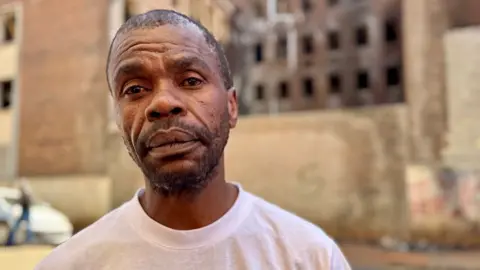The remnants of the Usindiso building in Johannesburg stand as a grim reminder of the tragedy that unfolded two years ago, claiming 76 lives. Once a haven for many who had nowhere else to turn, the building has now become a symbol of deep housing inequalities that plague South Africa’s wealthiest city.
Vusi Tshabalala, one of the survivors, recounts the fateful night of the fire. Awoken by flames, he and his companions managed to escape, but many others were not as fortunate. Their harrowing escape only marked the beginning of new struggles, as Tshabalala now lives in a makeshift settlement near the ruins of the Usindiso building, surrounded by violence and despair.
Despite initial promises from government officials to improve housing conditions in the area following the fire, little has changed. Survivors report living in fear, facing threats from ongoing gun violence and inadequate living conditions. Tshabalala moved multiple times in search of safety and work, only to find himself back where he started—living in temporary shelters constructed from wood and metal, a few feet away from where the building once stood.
The situation is dire for many, including Thobeka Biyela, another survivor who was shot in her temporary home. Reporting safety concerns, she expressed frustration over the lack of action from authorities, who had assured that her camp would be temporary. Biyela, who now struggles with her injury, calls for more security measures that have yet to materialize.
As South Africa prepares to host the G20 in November, the government has promised improvements in the inner city, yet many question if these changes will benefit the most vulnerable. Activists highlight that without affordable housing solutions, the cycle of poverty and displacement will continue, creating a dismal future for those still reeling from the tragedy of the Usindiso fire.
Vusi Tshabalala, one of the survivors, recounts the fateful night of the fire. Awoken by flames, he and his companions managed to escape, but many others were not as fortunate. Their harrowing escape only marked the beginning of new struggles, as Tshabalala now lives in a makeshift settlement near the ruins of the Usindiso building, surrounded by violence and despair.
Despite initial promises from government officials to improve housing conditions in the area following the fire, little has changed. Survivors report living in fear, facing threats from ongoing gun violence and inadequate living conditions. Tshabalala moved multiple times in search of safety and work, only to find himself back where he started—living in temporary shelters constructed from wood and metal, a few feet away from where the building once stood.
The situation is dire for many, including Thobeka Biyela, another survivor who was shot in her temporary home. Reporting safety concerns, she expressed frustration over the lack of action from authorities, who had assured that her camp would be temporary. Biyela, who now struggles with her injury, calls for more security measures that have yet to materialize.
As South Africa prepares to host the G20 in November, the government has promised improvements in the inner city, yet many question if these changes will benefit the most vulnerable. Activists highlight that without affordable housing solutions, the cycle of poverty and displacement will continue, creating a dismal future for those still reeling from the tragedy of the Usindiso fire.





















